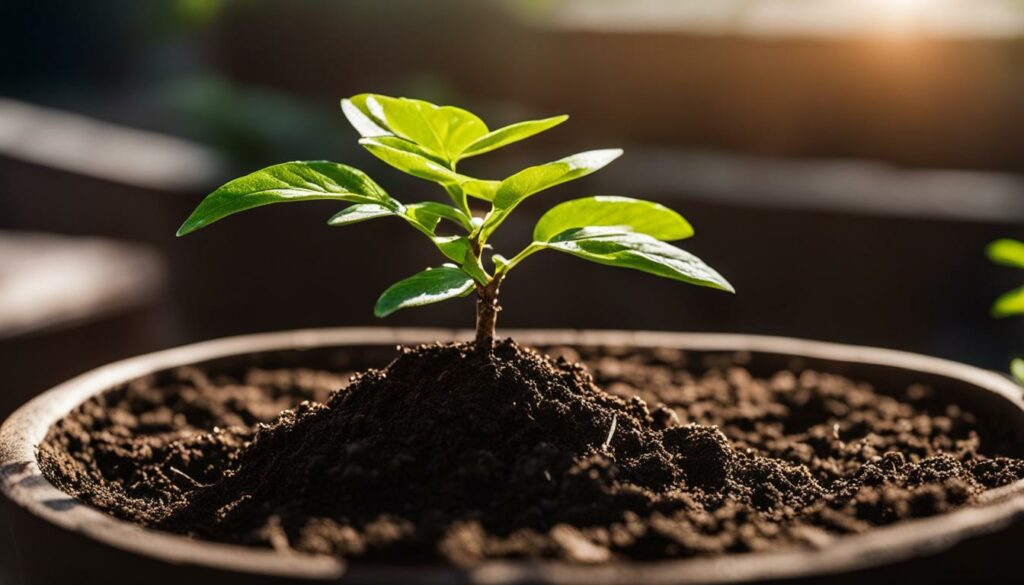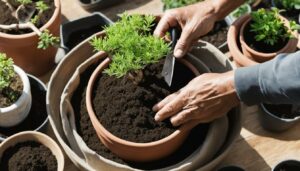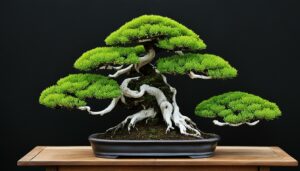If you are a plant enthusiast looking for a challenge, growing a bonsai tree from seed can be a fulfilling and engaging experience. This comprehensive guide will walk you through all the necessary steps to grow and care for your bonsai tree. Whether you are a novice or an experienced gardener, this guide will equip you with the knowledge and techniques needed to cultivate your own unique and impressive bonsai tree.
Key Takeaways
- Learn the art of bonsai cultivation and how to apply it to your seedlings
- Select the right bonsai seeds for your preferences and goals
- Master the step-by-step process of germinating bonsai seeds
- Provide proper seedling care to ensure healthy and thriving trees
- Explore different training techniques to mold your bonsai into a masterpiece
Understanding Bonsai Cultivation
Bonsai trees are unique and captivating expressions of the natural world. But what differentiates a bonsai tree from a regular tree? It’s all about the art of bonsai cultivation.
Before you get started on growing your bonsai from seeds, it’s important to understand the key principles and techniques behind this ancient artform. Bonsai cultivation involves shaping and pruning trees to create miniature versions of themselves, highlighting specific features and increasing their aesthetic appeal.
One of the most critical aspects of bonsai cultivation is choosing the right bonsai seeds. Bonsai seeds come in a variety of types, each producing a distinct type of tree with its unique characteristics. Understanding the differences between these seed types and how to choose the right ones is vital to ensure a successful growing journey.
Another key principle of bonsai cultivation is working in harmony with nature. Bonsai trees are grown in small containers, limiting their root growth and allowing them to mimic the natural growth patterns of trees growing on mountainsides or rocky terrain. Achieving this requires strict attention to seedling care, including providing proper lighting, watering, and temperature control.
As your bonsai tree grows from a seedling to maturity, you’ll need to use specific techniques to shape its branches and trunk and promote overall tree health. These techniques include pruning, wiring, and transplanting, among others. Understanding and applying these techniques will help you create a beautiful and unique bonsai tree.
Overall, understanding the art of bonsai cultivation is critical to growing a healthy and beautiful bonsai tree. Keep learning, experimenting, and applying your knowledge, and you’ll be well on your way to cultivating a thriving and breathtaking bonsai tree.
Choosing the Right Bonsai Seeds
Starting your bonsai journey from seeds is an exciting and rewarding experience. But, choosing the right bonsai seeds can make all the difference between an average and a spectacular growth journey.
There are many types of bonsai seeds available, from traditional to rare and exotic varieties. Some species are better suited for beginners, while others require more expert skills and care.
When choosing your bonsai seeds, consider your goals and preferences. Do you want a specific species, size, shape, or color? Are you looking for a challenge or a relaxing hobby?
Research different bonsai species to determine the ones that fit your needs. You can find bonsai seeds at local nurseries or online stores. Be sure to read the description and customer reviews before making your purchase.
Pro Tip: Look for reputable bonsai seed suppliers that offer a wide selection of quality seeds and excellent customer support.
| Bonsai Seeds | Description |
|---|---|
| Japanese Maple | A popular and versatile bonsai species with beautiful autumn colors and slender branches. |
| Juniper | A hardy and easy-to-grow species with needle-like leaves and an iconic bonsai appearance. |
| Chinese Elm | A fast-growing and forgiving species with small leaves, spherical canopy, and great adaptability. |
| Wisteria | A stunning and fragrant species with cascading clusters of violet flowers and elegant branches. |
Some bonsai seeds require special treatment before germination, such as stratification or scarification. Make sure to follow the instructions provided with your seeds or seek guidance from a bonsai expert.
Remember, choosing the right bonsai seeds is just the beginning of your cultivation journey. With patience, dedication, and proper care, your bonsai seed can grow into a magnificent living artwork that brings beauty and peace to your home or garden.
Germinating Bonsai Seeds
Germinating bonsai seeds is a critical stage in the cultivation process that requires patience and attention to detail. Follow these essential steps to ensure the successful germination of your bonsai seeds:
- Stratification: Place your seeds in a plastic bag with a moistened paper towel. Seal the bag and refrigerate it for four to twelve weeks. This process mimics the winter season, which triggers the seeds to germinate when placed in a warm environment.
- Soaking: After stratification, soak the seeds in warm water for approximately 24 hours. This process will initiate the germination process.
- Planting: Plant the seeds in a well-draining soil mix. Make a small hole in the soil and place the seed inside, covering it with a shallow layer of soil.
- Moisture: Keep the soil moist, but not waterlogged. Water the seeds lightly from the bottom to avoid disturbing them.
- Temperature: Place the planted seeds in a warm and humid environment, such as a greenhouse or humidity dome. The ideal temperature for germination is around 70°F.
With proper care and attention, your bonsai seeds will germinate and sprout into beautiful seedlings. Remember to be patient and consistent in your efforts to ensure the highest chances of success.
Seedling Care for Bonsai Trees
Congratulations! Your bonsai seeds have successfully germinated, and tiny seedlings have sprouted. Now comes the most delicate and important stage—nurturing the seedlings into healthy, robust trees. With proper seedling care, your young bonsai will thrive and develop strong roots, branches, and foliage.
The following are the essential elements of seedling care that you need to keep in mind:
| Element | Requirement |
|---|---|
| Watering | Your seedlings need consistent moisture to grow strong. Water them when the soil starts to dry out, but be careful not to overwater, as wet roots can cause root rot. Use a watering can with a fine nozzle to avoid damaging the soil surface or the seedlings, or try a drip irrigation system. |
| Lighting | Proper lighting is essential for healthy bonsai growth. Young seedlings require bright but indirect light, as direct sunlight can burn the tender foliage and scorch the soil. Consider using grow lights if natural light is insufficient. |
| Temperature | Bonsai seedlings need a consistently warm temperature to thrive. Keep them in temperatures ranging from 60 to 75°F (15 to 24°C) to encourage healthy growth. |
| Fertilizing | As your bonsai seedlings grow and develop, they require adequate nutrients to support their growth. Apply a balanced organic fertilizer to the soil or use a slow-release fertilizer tablet every four to six weeks in the growing season, according to the manufacturer’s instructions. |
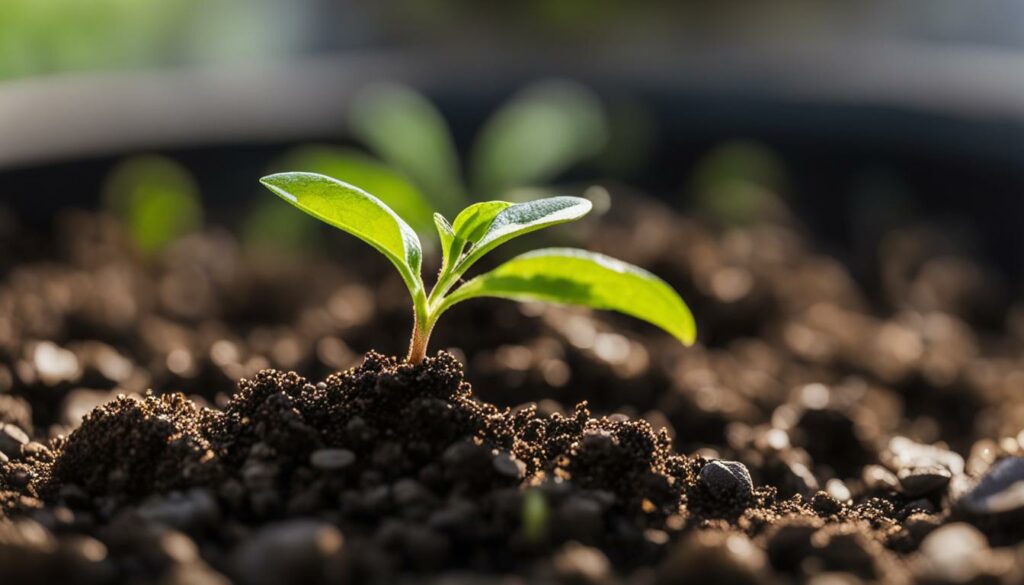
Remember to monitor your seedlings’ overall health, as they may sometimes require extra attention. Inspect them regularly for pests, diseases, or signs of poor growth, such as yellowing leaves or wilting foliage. With regular care and attention, your bonsai seedlings will thrive, and you’ll soon be on your way to cultivating beautiful, healthy trees.
Pruning and Shaping Your Bonsai
Once your bonsai seedlings have developed a few sets of leaves, it’s time to start thinking about their aesthetic. Pruning and shaping your bonsai is a crucial step in crafting a unique and stunning tree.
The goal of pruning is to remove unwanted growth from your bonsai, allowing it to focus its energy on the most important parts. You should prune your bonsai trees regularly to maintain their overall shape and health.
When shaping your bonsai, you will use pruning to craft the trunk and branches. Consider the desired shape of your bonsai and visualize what it will look like once it matures. It’s also important to let some branches and shoots grow freely so you can wire and shape them later.
| Tool | Use |
|---|---|
| Bud scissors | Clean and easy cutting of tender branches or buds |
| Branch cutters | Cutting branches up to 10mm in diameter |
| Knob Cutters | Removing branch knobs and jin creation |
| Wire cutters | Cutting bonsai wire without damaging branchlets |
When pruning your bonsai, always use the proper tools and techniques to ensure clean and accurate cuts. Avoid using scissors or regular garden shears, which can crush or tear the delicate bark of your bonsai.
Remember that shaping a bonsai is a continuous process and may take several years to achieve the desired look. Patience and regular attention will help your bonsai start thrive, grow, and mature into a stunning work of art.
Wiring Techniques for Bonsai Trees
Wiring is an essential technique in shaping the branches and trunks of your Bonsai start. By wrapping wire around the branches and bending them gently, you can create the desired shape and structure of your Bonsai. However, it’s essential to understand that wiring can cause damage if left to constrict around the branches for too long.
Here are the different wiring techniques to guide you:
- Single Wire: This technique involves wrapping a single wire around the stem of a branch and the trunk, then twisting and bending it to your desired shape.
- Double Wire: A more advanced form of the single wire technique, double wire involves using two wires twisted together to add strength and support.
- Guy Wire: This technique is used to bend larger branches or trunks that cannot be bent using wire alone. It involves using a strong wire to attach the trunk or branch to a stable object like a stake or rock, then slowly bending it over time.
When wiring your Bonsai start, consider the thickness of the branch or trunk and the direction you want to bend it. Place the wire at a 45-degree angle and wrap it around the branch or trunk in a spiral. Leave space between each wrap to avoid damaging the tree bark. Use pliers to twist the wire gently and bend the branch in your desired direction.
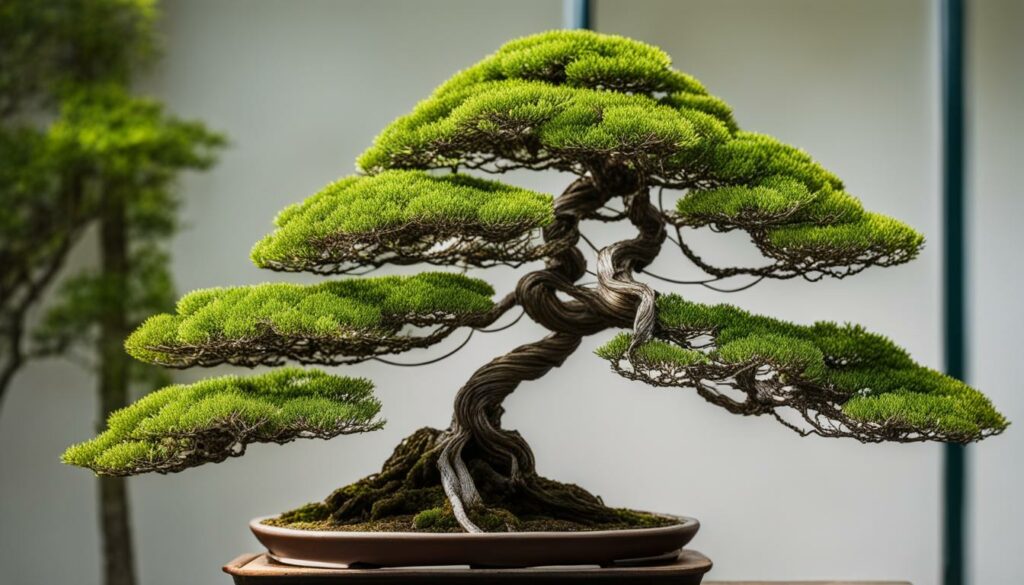
Transplanting Bonsai Seedlings
As your bonsai seedlings start to grow, they will eventually outgrow their initial containers, indicating the need for transplantation into larger containers. Transplanting your bonsai seedlings will provide much-needed room for root growth and allow for optimal nutrient absorption, ultimately leading to healthy and thriving trees.
The ideal time to transplant your bonsai seedlings is during the active growth period, typically in the spring or summer months. Here are the steps to follow for proper transplantation:
- Carefully remove the seedling from its current container and gently loosen the soil surrounding the roots.
- Trim any damaged roots or those that are circling around the container, causing root-bound conditions. This technique will promote new root growth and avoid stunted growth.
- Place the seedling in a new container, ensuring it’s the right size for your bonsai tree.
- Add new soil around the roots, filling in any gaps and gently compacting it to remove air pockets.
- Water the soil thoroughly, allowing the excess water to drain from the bottom of the container.
- Keep the newly transplanted bonsai seedling in a shady and cool place for a week or two to allow it to adjust to the new environment and recover.
Transplanting your bonsai seedling is a crucial step in your bonsai cultivation journey, requiring careful attention and technique. It sets the foundation for your bonsai’s future growth and development.
Get your bonsai off to a great “Bonsai start” by carefully transplanting your growing seedlings.
Pruning Bonsai Roots
Root pruning is a crucial aspect of bonsai cultivation and maintenance. It involves trimming the roots of your bonsai tree to promote healthy growth and development.
It’s essential to prune the roots of your bonsai regularly to prevent overcrowding, which can lead to root rot and other diseases. By trimming the roots, you not only keep them healthy but also ensure that your bonsai has enough space in its pot to continue growing.
To start root pruning, gently remove your bonsai from its container and carefully untangle the roots. Use sharp, clean scissors or shears to trim away any dead or rotting roots, as well as any large roots that are preventing the smaller ones from growing.
Remember to only remove about one-third of the root mass, as removing too much can shock and damage your bonsai. It’s also crucial to give your bonsai plenty of water and nutrients after root pruning to help it recover.
In addition to pruning roots, you can also use other techniques such as repotting, top dressing, and air pruning to maintain the health and vigor of your bonsai roots.
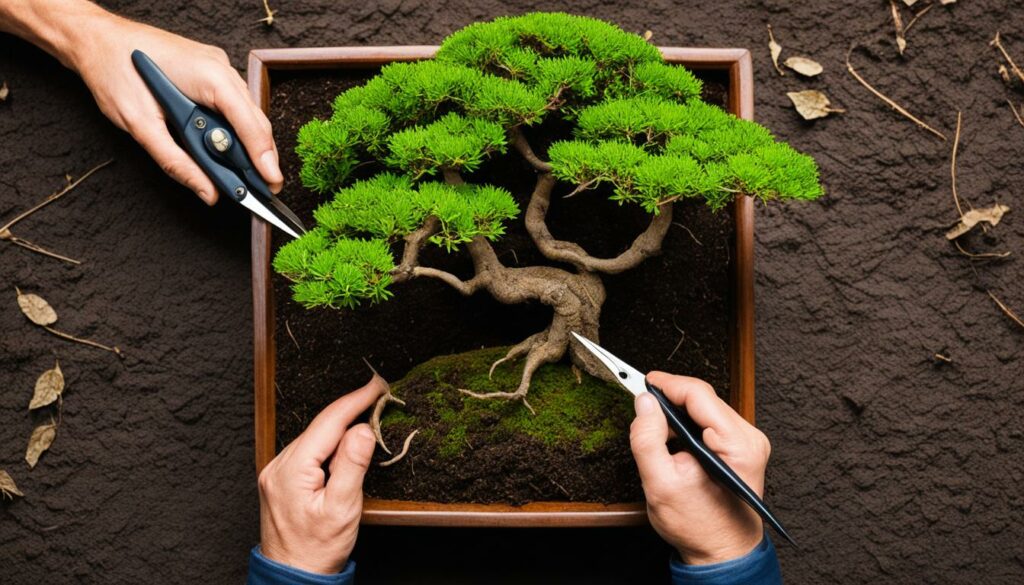
By mastering the art of root pruning, you can help your bonsai trees grow strong and healthy. Remember to only prune when necessary and to always provide proper care and nourishment for your growing bonsai.
Bonsai Soil and Fertilizer
As a bonsai enthusiast, you know that choosing the right soil and fertilizer is essential for the healthy growth and development of your trees. The type of soil that works best for your bonsai depends on the tree variety, location, and desired growth outcome. The composition of the soil affects every aspect of the tree’s life, including the availability of nutrients, drainage, and aeration.
For your bonsai start, you should select a soil mixture that has excellent water retention properties and high drainage capacity. A combination of organic and inorganic components, such as akadama, pumice, and lava rock, is ideal.
When it comes to fertilization, it’s important to avoid over-fertilizing your trees, which can lead to root burn and death. A balanced fertilizer with essential nutrients, such as nitrogen, phosphorus, and potassium, is typically used for bonsai trees. You can add organic fertilizers, such as bone meal and fish emulsion, to enhance the soil’s nutrient content.
Remember, when fertilizing your trees, it’s essential to follow instructions on the package and to avoid under or over-fertilizing.
Bonsai Soil Composition
| Component | Function |
|---|---|
| Akadama | Water retention and drainage |
| Pumice | High drainage capacity |
| Lava rock | Aeration and long-term nutrient release |
Ensure that the soil composition is balanced to provide the ideal growing conditions for your bonsai tree.
Fertilizer Application
- Apply fertilizer during the growing season, typically from spring to autumn.
- Use a balanced liquid fertilizer or slow-release pellets.
- Follow the instructions on the package to avoid over-fertilizing.
- Consider organic fertilizers, such as fish emulsion and bone meal.
- Adjust fertilization based on the tree’s needs and response to application.
Protecting Your Bonsai from Pests and Diseases
As you care for your bonsai start, it is essential to be aware of the common pests and diseases that can harm your tree. Insects, mites, and fungi are some of the most prevalent threats to bonsai health.
One of the most effective ways to prevent pests and diseases is to keep your bonsai in good health. A healthy tree is better able to resist infestations and infections. Regular watering, fertilizing, and pruning will go a long way in preventing pest and disease problems.
If, despite your best efforts, your bonsai does become infested or infected, quick action is crucial. The longer you wait, the harder it will be to control the problem. Fortunately, there are several treatment options available, from natural remedies to chemical pesticides.
Remember: prevention is always the best cure when it comes to pests and diseases. But if a problem does arise, don’t hesitate to seek help from a bonsai expert or a knowledgeable garden center.
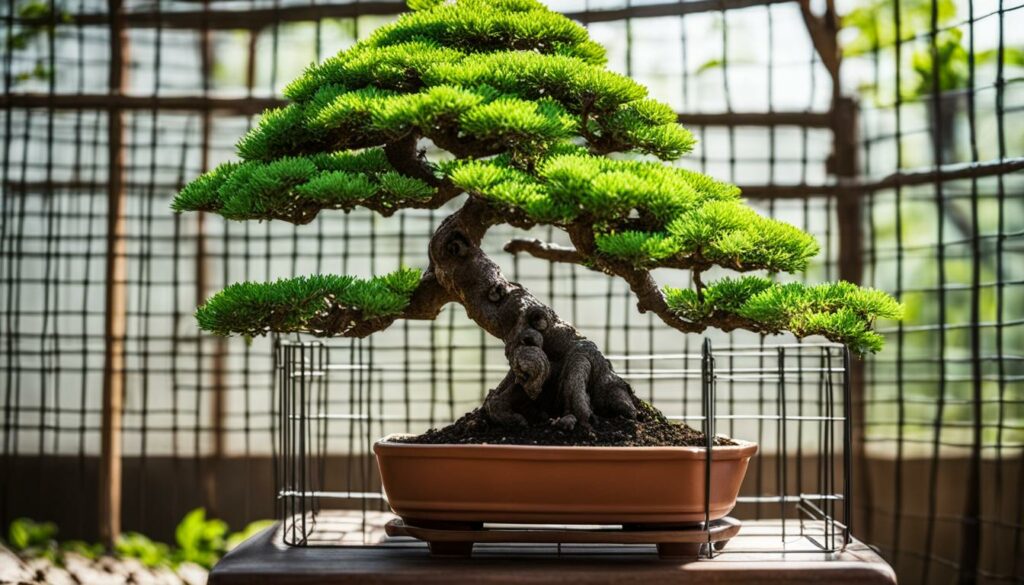
“The best defense against pests and diseases is maintaining a healthy bonsai.”
Bonsai Training Techniques
Now that your bonsai tree has started to grow, it’s time to start training it into the desired shape and style. This process involves using different techniques, including wiring, pruning, and bending, to mold your bonsai into a masterpiece.
One of the most common training techniques is wiring. This involves wrapping a wire around the branches and trunk of your bonsai to shape them in a particular direction. It’s essential to use the right wire gauge so that it doesn’t cause damage to the tree.
Another technique is pruning, which involves removing unwanted or overgrown branches and leaves to create a more refined aesthetic. It’s crucial to use sterile tools to prevent damaging the bonsai tree and to ensure proper healing after pruning.
Bending is another training technique that involves bending branches or the trunk to create a desired shape. It’s essential to exercise caution while bending to prevent breaking or damaging the tree.
Example:
“Training is the key to success in bonsai cultivation. It’s the process of pushing your trees to move into the direction you want them to take. It’s a slow process, but it’s worth taking the time and patience to make your bonsai its very best.” – ZZ Bonsai
Bonsai Repotting
One of the essential steps to maintain healthy bonsai trees is repotting. As bonsai trees grow, their root systems become restricted by the container and may become root-bound. Repotting your bonsai provides opportunities to rejuvenate the soil, remove dead roots, trim and shape the remaining ones, and to replenish essential nutrients. By repotting, You can encourage healthy root growth and overall plant vigor.
So, when is the best time to repot your Bonsai? Spring is the ideal time to repot for deciduous trees, and early summer is suitable for conifer species, although this varies with your location.
When repotting your bonsai, use appropriate soil compositions for bonsai cultivation. A mixture of Akadama, Pumice, and Lava rock is recommended as it drains well while providing adequate nutrients.
Remember to trim the roots before replanting them in the new pot. Avoid removing more than a third of the roots and using dull scissors or damaging the roots as that could stress the tree.
As always, water your bonsai before and after repotting to eliminate air pockets in the soil. Covering the topsoil with moss or grit helps prevent soil erosion and reduce any shock that the tree may experience.
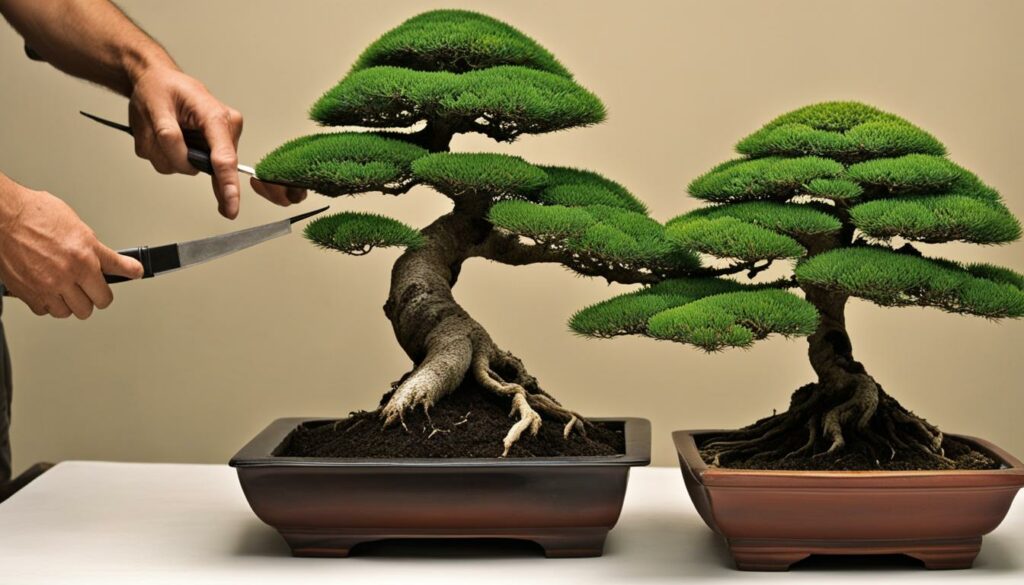
“Repotting is one of the essential and rewarding techniques of bonsai cultivation, it helps maintain the health and vitality of your bonsai trees by encouraging growth, preventing root-bound, and providing adequate nutrition.
Bonsai Winter Care
Winter can be a challenging time for bonsai trees. As the temperature drops and the days become shorter, your bonsai may need some extra care to make it through the colder months. Here are some essential steps to protect your bonsai and ensure it thrives come spring:
- Move your bonsai to a protected area, such as a garage or shed, to shield it from harsh winds and frost.
- Reduce watering and fertilizer application to avoid overwatering, which may cause root rot in cold temperatures.
- Monitor the soil moisture level regularly. Ensure the soil doesn’t dry out completely or become water-logged, both of which can harm your bonsai.
- Consider using grow lights to provide sufficient light if your bonsai is kept indoors.
By following these simple steps, you can help your bonsai survive the winter and come back stronger and healthier in the spring. Remember, bonsai care is a year-round practice, and winter care is an essential part of your bonsai cultivation journey.
Displaying and Appreciating Your Bonsai
Now that your bonsai tree has reached maturity, it’s time to show off its beauty and celebrate the art of bonsai cultivation. There are several ways to display your bonsai, and you can choose the one that suits your taste and environment.
You can display your bonsai on a special table or stand that elevates the tree and enhances its appeal. Alternatively, you can place your bonsai on a windowsill or a shelf, where it can be admired from different angles.
Note: Make sure to avoid placing your bonsai in a drafty or overly humid spot, as these conditions can negatively affect its growth.
When displaying your bonsai, it’s essential to consider the overall aesthetic and ambiance you want to create. You can choose a rustic and natural look by incorporating stones, moss, or other organic elements into your display. Alternatively, you can create a sleek and modern look by opting for minimalistic and clean-cut elements.
Remember to appreciate your bonsai tree regularly and care for it as a mindful hobbyist. You can incorporate bonsai appreciation into your daily routine by watering and pruning your tree regularly, observing its growth and behavior, and keeping track of its progress.
| Option | Description |
|---|---|
| Special stand or table | Creates a dedicated space for your bonsai tree, focuses attention on its beauty and craftsmanship, and enhances its overall appeal. |
| Windowsill or shelf | Allows you to showcase your bonsai from different angles and can be a great way to incorporate natural elements into your living space. |
| Wall-mounted display | Provides a striking and innovative way to display your bonsai tree, particularly in small spaces. |
| Group display | Placing different bonsai trees together can create a dynamic and cohesive display that showcases different styles and aesthetics. |
Conclusion
Cultivating and caring for bonsai trees from seeds can be a rewarding hobby that brings tranquility and joy to your life. You have learned about the key principles and techniques of bonsai cultivation, from selecting the right seeds to shaping and styling your trees.
Remember that growing bonsai trees requires patience, dedication, and attention to detail. Keep in mind the importance of proper care and maintenance, from providing the right soil and nutrients to protecting your trees from pests and diseases.
As you start your bonsai journey, enjoy the beauty and serenity of this mindful art form. With your commitment and passion, you can create stunning and unique bonsai trees that reflect your personality and style.
Thank you for joining us on this bonsai start journey. We hope this guide has been illuminating and inspiring. Happy growing!
FAQ
Can bonsai trees be grown from seeds?
Yes, bonsai trees can be grown from seeds. Starting from seeds allows you to have full control over the growth and development of your bonsai tree.
How long does it take for bonsai seeds to germinate?
The germination time for bonsai seeds can vary depending on the specific species. On average, it can take anywhere from a few days to several weeks for bonsai seeds to germinate.
What is the ideal growing environment for bonsai seedlings?
Bonsai seedlings thrive in a well-lit area with indirect sunlight. It’s important to maintain a consistent temperature and provide adequate humidity for their growth.
How often should I water my bonsai seedlings?
Bonsai seedlings should be watered when the soil feels slightly dry. It’s important not to overwater or underwater them, as this can negatively impact their growth.
When should I start shaping my bonsai seedlings?
You can begin shaping your bonsai seedlings once they have established a strong root system and developed a few sets of true leaves. This is usually after a few months of growth.
What is the best time to repot my bonsai seedlings?
The best time to repot your bonsai seedlings is during the early spring before they enter their active growth period. This allows them to recover and establish new roots in the fresh soil.
Are there any specific pests or diseases that affect bonsai trees?
Yes, some common pests and diseases that affect bonsai trees include aphids, scale insects, fungal diseases, and root rot. Regular inspections and proper care can help prevent and treat these issues.
How often should I fertilize my bonsai seedlings?
Bonsai seedlings should be fertilized every four to six weeks during the growing season using a balanced fertilizer. It’s important to follow the instructions on the fertilizer package for proper application.
Can bonsai trees survive outside during winter?
The ability of bonsai trees to survive outside during winter depends on the specific species and the climate in your area. Some bonsai trees are more tolerant of cold temperatures than others and may require protection or indoor care during winter.
How long does it take for a bonsai tree to reach its desired shape?
The time it takes for a bonsai tree to reach its desired shape can vary greatly depending on various factors, such as the species, growth rate, and the techniques used for shaping. It can take several years or even decades to achieve the desired form.
